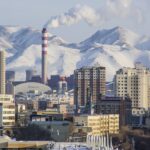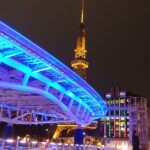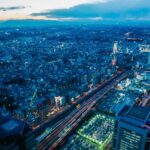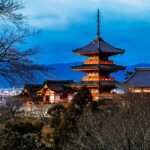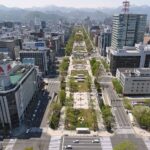The public transit in Sapporo, Japan, is legendary. The 3 lines that make up the Sapporo Subway’s extensive network of stops make it the city’s primary public transit system. The Sapporo Streetcar is a convenient means to travel about the city, and it links up with the metro system at several stops. The JR Bus, Chuo Bus, and other city bus routes are additional choices for getting about Sapporo. Sapporo is linked to the rest of Japan by way of the Hokkaido Shinkansen, the JR Hokkaido Railway, and the JR Chitose Airport Line. Sapporo’s public transportation system meets the needs of both locals and tourists by being dependable, convenient, and reasonably priced.
Metro system in Sapporo – 札幌市営地下鉄
Sapporo, Japan, is home to a metro system that serves the public. There are 3 lines: The Namboku Line, the Tozai Line, and the Toho Line which make up this system, and together they cover 48 kilometers and have 49 stops. Single-use tickets, stored-value cards, and monthly passes are just some of the ticketing alternatives that make this mode of urban transportation both convenient and affordable.
Namboku Line – Green
It connects Asabu Station in Kita-ku to Makomanai Station in Minami-ku and its name, South-North Line, comes from that fact. Stations along the Namboku Line are denoted by a “N” followed by a number, and the line’s color on maps is green.
Tōzai Line – Orange
The “East-West Line” connects the Nishi-ku neighborhood of Miyanosawa Station to the Atsubetsu-ku neighborhood of Shin-Sapporo Station. Stations along the Tzai Line are denoted by the letter “T” followed by a number, and the line’s color on maps is orange.
Tōhō Line – Blue
It connects the Higashi-ku neighborhood of Sakaemachi with the Toyohira neighborhood of Fukuzumi. The Th Line is depicted in a light blue on maps. The letter “H” is used as a prefix for its stations’ numbers.
Map of Sapporo Metro 2024 – Free Download in PDF

Click and download the map of Sapporo’s underground system for 2024
The Sapporo Metro Map will be useful if you plan a trip to Sapporo in 2024. This free PDF file is an excellent resource for learning about the Sapporo Metropolitan Area and its environs. It details not just the city’s many train routes and stations, but also its many attractions. It also includes specifics on the local conveniences and services that can be utilized. Getting around the city is a breeze if you have a copy of the Sapporo Metro Map 2024.
Public transport tickets – Best types for travelers & actual prices
In Sapporo, the One-Day Ticket is the standard. You can use it on the Sapporo Municipal Subway, the Sapporo Streetcar, and most local buses for a whole day. Depending on the day of the week, the price of a ticket might range from 310 yen to 520 yen.
The Sapporo Tourist 1-Day Passport provides unlimited travel on the Sapporo Municipal Subway, the Sapporo Streetcar, and local buses and is another popular alternative. Many of Sapporo’s top attractions offer discounts with the purchase of this ticket. The passport costs 800 yen.
The Sapporo 2-Day Passport is ideal for those who will be in the city for longer than 24 hours. Use of the Sapporo Municipal Subway, Sapporo Streetcar, and local buses is unlimited for two days with this ticket. There are discounts to a number of different Sapporo attractions included as well. The passport will set you back 1500 yen.
The Sapporo 3-Day Passport is another handy option for visitors. The three-day validity of this ticket allows you unlimited use of the Sapporo Municipal Subway, the Sapporo Streetcar, and local buses. There are discounts to a number of different Sapporo attractions included as well. The price of a passport is two thousand yen.
Summary of fares for public transport in Sapporo
- Standard one-day tickets range in price from 310 to 520 yen.
- A Vacationer The 1-Day Passport saves you 800 yen
- Discounts to attractions are included in the price of the 2-day Passport, which is 1500 yen.
- Discounts to attractions are included in the price of a 3-day Passport, which is just 2,000.
Timetables & Schedules of Sapporo Metro
The Sapporo Metro system connects all city areas and provides fast, easy, and convenient transportation. Scheduled hours are Monday through Friday, 6 a.m. to midnight, and Saturday and Sunday, 8 a.m. to midnight. The Namboku Line connects the city’s northern and southern neighborhoods, while the Toho Line traverses the city from east to west and the Tozai Line does the same in the city’s northern reaches. All lines operate frequently during the day, and some even run until 1 am on weeknights. There are also late-night bus and taxi services available at several of the stations.
Other Options For Public Transportation In Sapporo
Sapporo residents and guests can take advantage of a wide variety of public transportation choices to get around town. You can take the JR Sapporo City Subway, the JR Hokkaido Bus, the Chuo Bus, the Donan Bus, the Toei Bus, a Chuo Taxi, or the JR Hokkaido Bus. The JR Hokkaido Bus is Sapporo’s primary bus service and operates routes to all corners of the city. The Chuo Bus is a more compact bus service that travels to outlying areas of Sapporo. Sapporo’s other Hokkaido cities and towns can be reached by the Donan Bus, a regional bus service. The Toei Bus is a private bus service that travels to several locations in the Sapporo area. In the city itself and its surrounding suburbs, you can hail a Chuo Taxi. Finally, the city is connected with the JR Sapporo City Subway, a subterranean train system.
public bus transportation in Sapporo
Public transportation in Sapporo is managed by the Sapporo Municipal Transportation Bureau (SMTB). There are regular buses, express buses, and a night bus service all part of this network. Each bus has climate control and may accommodate passengers using wheelchairs.
The standard bus schedule operates daily from 6:00 AM to 11:00 PM. Each bus route in Sapporo is numbered, and you may use that to figure out where it goes. Popular bus lines in the city include the 100, 101, 102, 103, 104, 105, 106, 107, and 108.
On select routes, express buses are also available; these routes have a “E” before the route number. These buses travel more quickly and make fewer stops than most others. The E1, E2, E3, and E4 express bus lines are Sapporo’s most traveled.
From midnight until 5 am, Sapporo has a special bus service that may be recognized by the letter “N” at the beginning of the route number. Travelers can still go around the city after regular bus service has ended, as this option is provided on specific routes. Sapporo’s N1, N2, N3, and N4 lines are the city’s busiest after dark.
Special services provided by SMTB include the Sightseeing Bus, Airport Limousine Bus, and Sapporo City Loop Bus, in addition to the normal buses, express buses, and night buses. These services provide visitors with a simple and hassle-free method to see all that Sapporo has to offer.
How To Get From New Chitose Airport (CTS) To The City Center With Public Transport?
Taking public transportation from New Chitose Airport to the heart of the city is a quick and painless experience. New Chitose Airport is the best place to begin your journey, as it is only 31 kilometers from Sapporo, Japan’s fifth largest city. Access to the heart of the city makes traveling around the area a breeze.
The train is the quickest and most hassle-free option for traveling between New Chitose Airport and the heart of the city. Sapporo Station, the city’s primary train terminal, can be reached in a little over 30 minutes on the JR Chitose Line. It leaves around once every half an hour and costs about 1,040 yen. To reach your final destination, you can also take the Airport Rapid Service from the airport to Shin-Chitose Station.
You can also take a bus from the airport into downtown if that’s more your speed. It takes about 50 minutes on the Chuo Bus to get from the airport to Sapporo Station. The fee is 1,030 yen. From the airport, you can take a long-distance bus to Asahikawa, Hakodate, or Kushiro, all of which are located within Hokkaido.
It is simple and convenient to use public transportation from New Chitose Airport into the heart of the city. With direct access to Sapporo, tourists don’t have to bother about renting a car or hailing a cab to get where they need to go.
spend 3 days in Sapporo
Sapporo, Japan is the place to go if you want to immerse yourself in a vibrant urban environment and have a truly memorable experience. There is a lot for a tourist who is visiting for the first time to see and do, what with the exciting nightlife, wonderful local cuisine, and interesting cultural sites. Here is a suggested itinerary for spending three days in Sapporo.
Day 1:
The Sapporo Beer Museum is an interesting place to start your day. The museum’s focus on the city’s signature beverage gives visitors a unique perspective on the area’s heritage and culture. After your museum visit, relax in Odori Park, a favorite among both locals and visitors. You’ll be able to take in the urban landscape and atmosphere.
Visit the Sapporo Clock Tower to wind off the day. This landmark building dates back to 1878 and is an excellent vantage point for the sun setting in the horizon. After that, party it up in Susukino, the city’s entertainment zone, and feast on some of the best local cuisine.
Day 2:
On your second day there, check out some of the city’s museums and historical sites. The Historical Village of Hokkaido, a reconstructed community showcasing the culture of Japan’s early inhabitants, may be reached through the Sapporo City Subway. The Sapporo TV Tower is an iconic landmark with breathtaking views of the city, so be sure to visit afterward.
Take in one of Sapporo’s most well-attended events, the city’s annual Snow Festival, before calling it a day. Amazing ice sculptures will be on display, and there will be a variety of exciting winter activities to enjoy.
Day 3:
If you’re a beer aficionado, you should spend your last day in Sapporo at the Sapporo Beer Garden. Participate in a beer tasting and tour to discover the city’s brewing history. After that, stroll the city’s lively retail districts and pick up some mementos to remind you of your trip.
Get your day’s worth of singing in at one of the city’s many karaoke bars before calling it a night.
Sapporo is a bustling metropolis with many attractions. You can discover whatever it is you’re looking for in this incredible city, be it a one-of-a-kind adventure, mouthwatering cuisine, or thrilling nightlife.
What other SUBWAY systems are nearby to Sapporo?
Japan boasts an extensive network of subway systems beyond the famous Tokyo Metro. Osaka Metro, the second largest in the country, operates eight lines covering a significant portion of the Osaka Prefecture. In the historic city of Kyoto, the Kyoto Municipal Subway system enables easy access to various cultural and tourist sites. The Fukuoka City Subway extends across the Fukuoka Prefecture in Kyushu, while the Sendai Subway operates in the Miyagi Prefecture. Additionally, cities like Yokohama, Kobe, and Nagoya each have their efficient subway systems, reflecting Japan’s commitment to excellent public transportation.
AWESOME VIDEO TOUR GUIDE ABOUT PUBLIC TRANSPORTATION IN Sapporo
Summary of our tour guide for Sapporo
I’ve spent my entire life in Sapporo, so I know my way around the city’s public transit system inside and out. I’m well-versed in all the city’s train options, from the Sapporo Municipal Subway to the JR Hokkaido Railway. In addition to the trams and cabs, I’ve made frequent use of the city’s bus system. Sapporo’s public transit system is renowned for its dependability and timeliness, making it simple to travel throughout the city at little cost and in a short amount of time. I also value the fact that many buses and trains in the city have wheelchair lifts and ramps to make them accessible to individuals with impairments. Sapporo’s public transportation system is fantastic, and I’ve gotten to know it quite well.
Top 5 FAQs and answers about Sapporo public transport?
- Which modes of public transportation are the most often used in Sapporo?
- Sapporo residents typically take the bus, tram, or metro while traveling about the city. Buses are the most frequently used kind of public transportation since they are quick, cheap, and accessible to most areas of the city. Many of Sapporo’s top sites may be reached via the city’s convenient tram system. Sapporo’s metro system connects all of the city’s neighborhoods quickly and efficiently.
- How much does it cost to ride the bus in Sapporo?
- Sapporo’s public transportation fares change based on the mode of travel and distance traveled. For example, a single-journey ticket on the subway costs ¥220, while a day pass costs ¥630. Bus fares might cost anything from $ 200 to $ 400. A single tram ride will cost you 200, while a day pass will set you back 500.
- Where can I get tickets for Sapporo’s public transportation?
- Using a prepaid “Suica” or “Pasmo” card is the most convenient way to purchase tickets for public transportation in Sapporo. These cards are available for purchase at any metro stop or 7-Eleven and can be used on any of the city’s public transportation systems. Single-ride tickets are also available for purchase at any stop or on any mode of transportation.
- I was wondering if Sapporo’s public transportation offered discounted tickets.
- Yes, Sapporo’s public transportation system provides various discounted tickets. Daily passes, group tickets and monthly memberships are all available. Day passes are the best deal because they let you use the system for an entire day without incurring any additional costs. Tickets for groups of two or more can be purchased here. Regular riders of the public transportation system can purchase monthly passes.
- Do you have any advice for navigating Sapporo’s public transportation system?
- Yes, a few things to remember when taking the bus or subway in Sapporo. First, plan ahead by double-checking each mode of transportation’s timetable. This will guarantee that you won’t run late. I think it’s best to schedule your trip around the fact that the subway stops operating at midnight. Finally, a map of the city’s public transportation system will come in handy at any time.
Useful links



